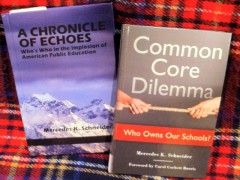Betsy DeVos Pitches Virtual School with 4-Yr Cohort Grad Rate Below 32 Percent
On March 20, 2017, US Secretary of Education Betsy DeVos addressed the National Association of State Boards of Education in Washington, DC.
Her speech includes the repeated, slanted story of Denisha Merriweather, whose story of private school success coincided with the stabilization of her home life— and whose private school has an established record of low math test scores.
Of course, DeVos does not mention such pesky details. Instead, she simplifies Merriweather’s story to suit her narrative of private school choice saving a student from those deficient public schools.
In short, when it comes to her shaped Merriweather narrative, DeVos continues to lie.
In this speech, DeVos follows her Merriweather tale with one about a student whose academic life was rescued by his attending a Washington State virtual school:
Another student I met, Sandeep Thomas, grew up impoverished in Bangalore, India with absent and neglectful parents. Sandeep was adopted by a loving couple from New Jersey but continued to suffer from the experiences of his early years. He was not able to focus in school, and it took him hours to complete even the simplest assignment.
This changed when his family moved to Washington state, where Sandeep was able to join a virtual public school. This option gave him the flexibility to learn in the comfort of his own home and develop at a pace that was right for him. He ended up graduating high school with a 3.7 GPA, and also having earned 39 hours of college credit. Today, he’s working in the finance industry and is a public advocate for increased school options that allow students like him a chance to succeed. …
Only moments later, DeVos urges members of state boards of education to focus on trees, not the forest:
All of these students’ experiences suggest that we should value and appreciate the individual trees rather than see a monolithic forest. Let’s stop prioritizing process over people. If our actions don’t benefit students at the individual level, there is no reason for us to pursue them.
So, I took her up on her offer to focus on the tree.
I looked on Sandeep Thomas’ Linkedin bio to discover the exact virtual school that he attended: Insight School of Washington (2007-2011).
However, by DeVos’ standards, I slipped. I failed to continue to focus on the success of the Thomas tree and shifted my attention to the Insight School of Washington graduation rate forest.
The results are not pretty.
The following information comes from the Washington State Report Card search engine.
Here’s some forest for you:
Thomas was part of the Class of 2011 graduation cohort.
Only 19.1% of that cohort graduated on time (within four years).
If one extends the Class of 2011 cohort to five years, the graduation rate, uh, rises to 23.6%. (Note that this percentage also includes the 19.1% who graduated in four years.)
Given my interest in the forest created by the trees, I compiled the 4-year and 5-year cohort graduation rates as far back as Washington State utilized cohort graduation rates (2009-10).
From 2006-07 to 2009-10, Washington State also included the percentage of Insight students who dropped out.
It isn’t pretty.
The most recent dropout rate for Insight approached half of its 2009-10 enrollment: 44%.
And if one considers four-year cohort graduation rates, Insight School of Washington has yet to break 32%. But if one allows the extra year, the rate rises to almost 37%.
Betsy DeVos will not be advertising these numbers.
However, she will likely continue to promote the story of one student from among that Class of 2011 19.1% of on-time graduates.
Trees are better for hiding embarrassing forests.
________________________________________________
Adjusted 4-Year (On Time) Cohort Graduation Rate:
- Class of 2015: 31.6%
- Class of 2014: 27.7%
- Class of 2013: 23.0%
- Class of 2012: 19.1%
- Class of 2011: 19.1%
- Class of 2010: 19.5%
Adjusted 5-Year (No More Than One Extra Year) Cohort Graduation Rate:
- Class of 2014: 36.6%
- Class of 2013: 30.0%
- Class of 2012: 24.8%
- Class of 2011: 23.6%
- Class of 2010: 23.5%
- Class of 2009: 19.9%
Annual dropout rate (i.e., not counting confirmed transfers or deceased students):
- 2009-10: 44.8%
- 2008-09: 34.5%
- 2007-08: 38.1%
- 2006-07: 35.7%
________________________________________________
___________________________________________________________



Thank you!!! The forest is our future.
Oh, please. 19.5 to 31.6 for the 4-year cohort? John White would call that roaring 62% growth THE BEST SCHOOL in the state, qualifying for quadruple secret bonus points and a photo op to boot! You have to BELIEVE! (proof optional)
Reblogged this on David R. Taylor-Thoughts on Education.
DeVos wants a story unhinged from facts–fictions, fantasies.